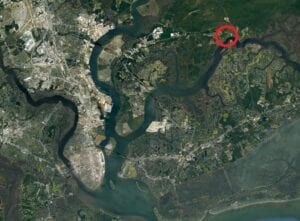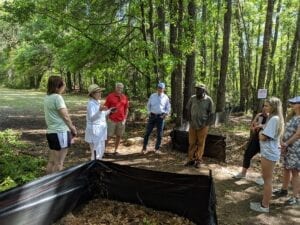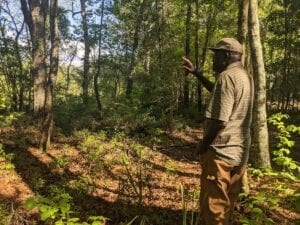Advocacy Alerts
Cainhoy Peninsula Subdivision Development Halted to Protect African American Burials
preservation-admin , May 10, 2021
by Brian Turner, Preservation Society of Charleston Director of Advocacy
Last week, state regulators issued a stop-work order to protect an African American burial ground in Cainhoy from an encroaching residential subdivision. The order references new physical evidence of graves brought forward by community advocates and Councilmember Marie Delcioppo.
The move is a major breakthrough in a long-simmering dispute about the precise boundaries of the cemetery and a major win on an issue the Preservation Society has been working with partners to resolve for nearly six years.
The residential development, called Oak Bluff, was first proposed in 2010 and the western portions of the subdivision have already been completed. The third phase of the project has been the most contentious as it directly impacts a significant, yet understudied archaeological site, including multiple burial grounds.
The area includes the approximately one-acre McDowell Cemetery which is privately owned and dates to the 17th century. McDowell constitutes just a part of the archaeological site with a layered history extending from Native American occupation to the construction of a 1699 dissenter church from New England and, as recorded in General Moultrie’s memoirs, a Revolutionary War hospital. Archaeologists have not questioned the presence of burials extending to the north of McDowell, but no definitive work has been conducted to determine its boundaries. Land disturbance permits recently requested by the developer for the third phase of Oak Bluff had been accompanied by incomplete data.

On March 10 the Preservation Society wrote to the Department of Health and Environmental Quality (DHEC) to express our concerns about the permit request. Based on our conversations with community members, advocates, and descendants, including the Gullah Society, the unmarked burial ground is much larger than the reports disclosed. While site maps relied on during the permitting process show 13 burials, research and correspondence with descendants suggested there are upwards of 40. These discussions led to our conclusion that there would be a “strong likelihood” for the applicant to encounter burials in the grading work that precedes residential construction.
It turned out the permit had already been issued. This was news for the advocates involved who had not been notified, even the adjacent owner of McDowell Cemetery. A flurry of media followed included queries of the developer, Crescent Homes, who indicated their intent to forge ahead. The developer took the position that all rules had been followed and neither the state nor city had the legal authority to compel any further site review. Advocates worried that it would take an unnecessarily exposed burial to actually halt work.
Then, on May 5, DHEC issued a stop-work order. Technically the agency had invoked the “inadvertent discovery” clause due to a likely inadvertent discovery of human remains. In order to restart work, the developer will need to conduct a further investigation of probable burials.
The clause relied on by the state is a standard condition in land disturbance permits providing regulators the authority to order work halted in the event that new cultural resources and/or archaeological materials are found during the development process. And, while standard, the clause is frequently overlooked. Rarely is there sufficient supervision or oversight of work that has the potential to impact sensitive sites like burials. It is typically up to construction crews to report who may simply look the other way.
Two factors made the difference here. First, on April 30, the developer had crews clear vegetation in the vicinity of McDowell Cemetery, much to the chagrin of community leaders. Crude as this vegetation removal was, and though it may have had negative impacts on the integrity of the site, it led to the tentative identification of up to eight likely gravesites.
Most importantly, the community activism that sparked political leadership inspired this outcome. City Councilmember Marie Delcioppo, State Representative Mark Smith, and Mayor John Tecklenburg all engaged on the issue. Delcioppo, in particular, served as the primary connection between local advocates, the developer, and state regulators, ultimately sharing the critical information about the gravesite discoveries that led to the stop-work order.
We are proud to stand with our partners at the Gullah Society, Daniel Island Historical Society, and Cainhoy Methodist Church and Cemetery Corporation to ensure that dignity is given to all the unmarked burial sites in the area, acknowledging that the stories of those who rest there are at risk of being forever lost to time. Moving forward, advocates can take stock in the fact that supplemental review of the site will occur by professional archaeologists and that the public will have greater assurance about the extent of the cemetery prior to any further development activity.


